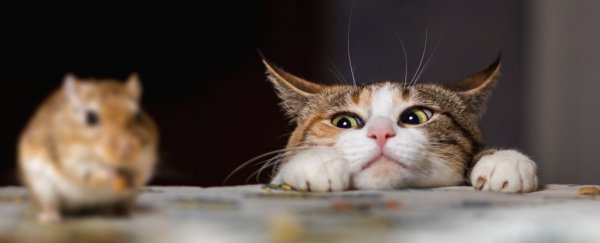You'd probably think that a city with a feral cat population and a feral rat population would end up with fewer rats due to the work of… the feral cats. But it turns out that, just like humans, cats may prefer the path of least resistance - and that includes opting for easier prey.
On a study of cats performed in New York city, researchers found that the feline hunters, despite their famed hunting prowess, only rarely hunted rats - which could put a pin in the idea of using cats to deal with a growing rat problem, as has been proposed for Chicago.
Using microchipped members of a rat colony in a Brooklyn industrial waste recycling facility and field cameras, scientists from the US and Australia conducted research to determine the effect of cats on the colony.
From 27 December 2017 through 28 May 2018, they recorded 306 videos of cats and/or rats that shared the same space.
Of those videos, cats were seen in 259. Yet there were only 20 instances of cats stalking the rats; and only three instances show the cat actively pursuing a rat, with two resulting in a successful kill.
That likely has something to do with the rats themselves. Although cats in island populations have been known to prey heavily on rats, those rats are pretty small, coming in at around 150 grams.
Even in Australia, where cats have been found munching rats, their meals tend to be long-haired rats, which also weigh around 150 grams.
But the rats in New York (and Chicago, for that matter, and dominating across North America and Europe) are Norway rats. These are hefty fellows, over twice the size of island rats, at 300 grams.
In the two instances where cats were recorded to successfully nab a Norway rat, those unlucky individuals were likely smaller members of the colony, the researchers said.
The reason cats likely tend to avoid the rats? "Cats prefer defenseless prey," the researchers wrote in their paper. And a hefty rat can deliver a much heftier fight than a mouse, bird, lizard, cockroach or - best of all - scavenged food scrap.
The team also noticed something interesting: when the cats were around, there were fewer rat sightings. That didn't mean the rats weren't around; but they have also learned to avoid the cats.
"Even though rats were less likely to be seen, they simply shifted their movements and remained present in the system. Our findings that cat presence led to fewer rat sightings may explain the common perception of their value as rat-predators despite the associated risks," the researchers wrote.
"Our results at a waste recycling facility … suggest that city rats can persist in high density, simply by altering their movements, despite the presence of hunting cats."
The team's research has been published in the open access journal Frontiers in Ecology and Evolution.
